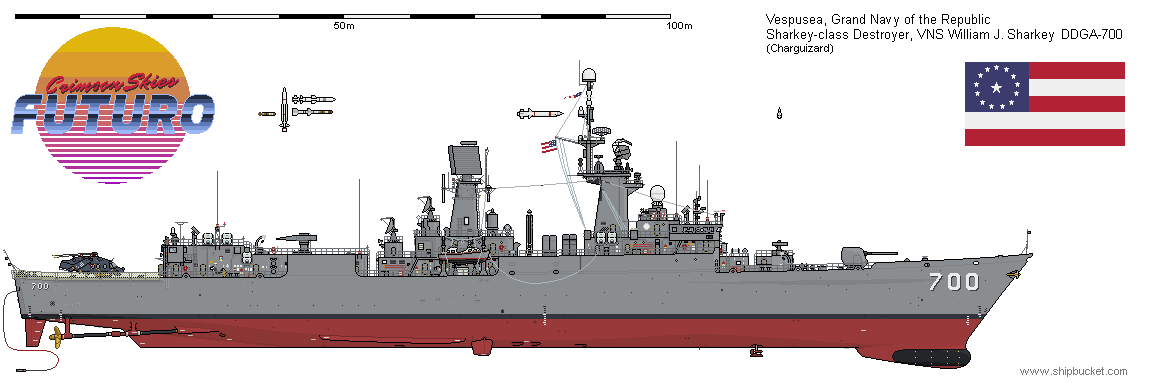Outer Screen Guided Torpedo Destroyer
This proposal is known as the Outer Screen Guided Torpedo Destroyer and represents the minimum hull necessary to carry the Mk 74 Fire Control System and Mk 26 Guided Missile Launch System on an atomic powered ship that can do fleet speed (30+ knots). She represents one of the many possible ships proposed for the Atomic Task Groups (ATGs) centered around a medium sized atomic carrier. As the name states, this destroyer would serve as a radar picket and anti-air warfare asset on the outer screen, sailing together and providing cover for the ATG’s ASW Destroyer Escorts. Provided with an UHF search radar, an S-band 3D radar and two channels (potentially three if the CAS is tasked with this) for RIM-66 direction, she can perform at a basic level all of the anti-air warfare tasks of the era. The Sea Mauler provides point-defense against leakers and missiles, though with only 7nmi of range, it can hardly be used to defend other ships. Her ASW fit is not inconsiderable either, the powerful SQS-53 providing targetting for ASROC and lightweight torpedoes. Her embarked LAMPS III helicopter can augment the task force’s airborne ASW compliment. The Agusta-Bell HS2L comes in either -1 variant equipped with 15 sonobuoys and MAD towed bird, or -2 equipped with dipping sonar and 6 sonobuoys, each version contributing a fraction of the capabilities of the larger Pitcairn dedicated ASW helicopters. Other tasks of the LAMPS aerocraft include VERTREP, search and rescue, and personnel transport between ships. Four Martin Outer Perimeter Defence Missiles are carried in boxes to be used either against maritime patrol or early warning aircraft staying out of range, or in case of saturation attack, since these missiles would not need to use any of the limited guidance channels.
The Atomic Task Groups are the result of the naval plan of 1968 that called for a rationalization of atomic reactor procurement, by which all atomic surface combatants would be powered by the Common Surface Warship Reactor (CSWR), a pressurized water reactor developed by General Electric from 1963, intended to output 40,000 shp through two steam turbines. The reactor would enter service in 1974 and ended up outputting 39,900 shp. The notional surface warships would be divided into segments according to the number of reactors installed as follows:
Destroyer Escorts, Destroyers: 1 reactor, 39,900 shp Large Destroyers, Light Cruisers: 2 reactors, 79,800 shp Cruisers, Light Carriers: 3 reactors, 119,700 shp Carriers: 4 reactors, 159,600 shp
I originally sketched this hull to draw a minimum ASW FFN, a ship intended to be as affordable as a nuclear ship could be. Thanks to ace, many changes ensued. The hull became longer, to the 485ft wl seen here after the first sketch, because the 39,900 shp of the reactor couldn’t get the smaller ship anywhere near to 30kn. Later, she had her beam increased and cB reduced. Eventually, her draught fell drastically and she finally reached her current form, down from a max displacement of 5,800t full, well into cruiser territory for sure. That ship was intended to be eminently comfortable and very constrained in mission and capability. Mission creep was to be confronted with extreme prejudice.
While this ship is rather large for the constrained requirement given, (Mk 74 FCS + Mk 26 GMLS), the hull size required to house the reactor and sail at 30kn gave me plenty of space to work with and add more systems. A more austere ship would use a smaller mod of the Mk 26, ditch the SPS-40, the Sea Mauler, the helicopter and probably use a 3” gun instead. As it is, and despite my efforts to prevent mission creep, the ship is no longer the comfortable cruiser that this hull was intended to be. Part of the issue was me using this hull for the Mk 26, which prompted ace to point out that, given the launcher’s ASROC capability, the ship should be equipped with a sonar capable of providing targeting for this weapon. Otherwise, the ship might be better served by two Mk 13 launchers instead. So in order to keep the Mk 26 justified, she became a proper multirole ship, which incidentally meant growing out of the Frigate classification (not used by the parent Navy). In any case, the AAW role is definitely served better by a 2 reactor DLG/cruiser sized ship, and I’ll draw that eventually too. Getting more guidance channels would be a priority then.
The C3G reactor is obviously fictional and is a result of me noticing an apparent lack of development on surface ship reactors in the USN, which brought me to extrapolate a reactor based on hp/t figures of real reactors. I forgot 💀 exactly what method I used to extrapolate this but I trust my past self to have done a reasonable job.
Displacement: 4,400t light 4,700t full Length: 485ft (147.8m) wl 510ft (155.5m) oa Beam: 48.5ft (14.8m) extreme Draught: 17ft (5.2m) full Block coefficient: 4.48 Propulsion: One C3G pressurized water reactor Two Westinghouse steam turbogenerators Two General Electric motors on two shafts, 39,900 shp Speed: 29.8kn sustained 27kn expected average cruising Range: Unlimited Complement: 316 Sensors & Processing:SPS-10 surface search radar SPS-40 air search radar SPS-48C 3D radar Civilian X-band surface navigation radar Mk 74 FCS SPG-51 illuminator Mk 87 FCS Combined Antenna System (egg) SQS-53 active sonar NTDS EW & Decoys: WLR-1 electronic warfare suites SLQ-25 Nixie torpedo decoy RBOC Armament: Mk 26 mod 2 GMLS, 64 rounds usual loadout of 40 SM-1, 16 ASROC, 8 Harpoon Twin arm reloadable Sea Mauler launcher, 40 rounds Mk 45 135mm/50 autogun Outer Perimeter Defence Missile (conventional warhead) on four box launchers Mk 46 18” (457mm) torpedoes on four fixed tubes Two 20mm Contraves pintle mounted autocannon Aircraft: One Agusta-Bell HS2L LAMPS III
